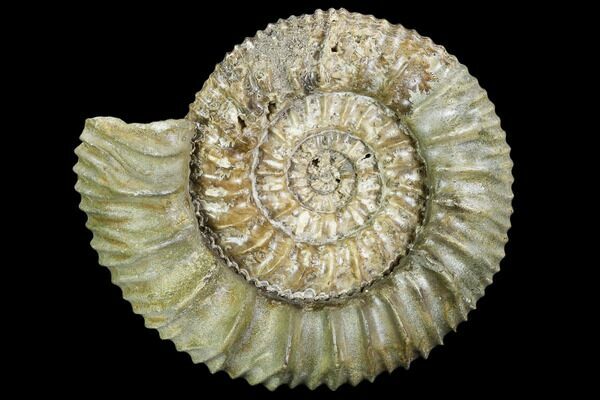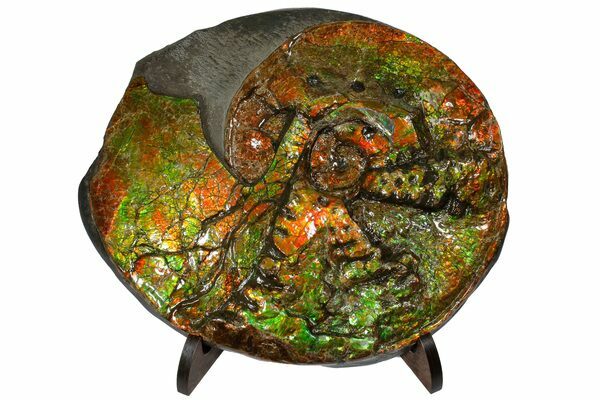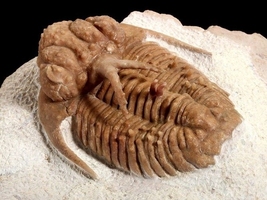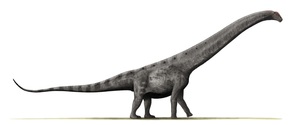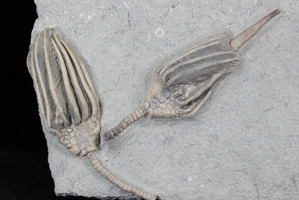About Ammonites
Ammonites were predatory mollusks that resembled squid. These cephalopods had eyes, tentacles, and spiral shells. They are more closely related to a living octopus, though the shells resemble that of a nautilus. Ammonites first appearing in the fossil record 240 million years ago, descending from straight shelled cephalopods. The last lineages disappeared 65 million years ago at the end of the Cretaceous.
Anatomy
Ammonites maintained buoyancy via a biological pump and siphon system called a siphuncle. The siphuncle connected the living chamber with the older parts of shell.
Many Ammonites floated or swam above seafloors that lacked oxygen to support animal communities. When they died, they drifted to the bottom and bacterial decomposition altered the redox chemistry of the water- making minerals less soluble and thereby concreting around the ammonite. This scenario promoted excellent preservation of shell material. Though soft tissues are poorly preserved, some ink sacs and beak-like jaws have been found. The rapid evolution of distinguished genera, their subsequent extinction after a few million years, and the excellent preservation of unique shell features make ammonites an excellent index fossil.
Ammonites shells are found with a variety of spiral types. Most are planispiral, though some have helical forms or no spiral at all. The phragmacone pertains to the chambers which control buoyancy and are separated by septae. The septae form suture patterns which have an elaborate, folded design. The sutures are on the inside of the shell, where the septa meet the inner wall. The beautiful patterns would have been hidden behind the protective, outer part of the shell on the living animal.
The septa of the ammonoid are convex, with the curve pushing outward to the opening, while nautiloid septa are concave with the curve pushing inward to the older parts of the shell. The septae of a nautiloid resemble a dish curving away from the body chamber. The last and largest of the chambers, the body chamber, was once believed to be protected by a hard aptychus- though now some scientists think this fossil remnant is part of the jaw. Ammonites likely had a radula and beak, a crop, and ten arms to grasp prey of small fish, crustaceans, crinoids, and even small orthoceras. Some ate plankton.
Evolution and Taxonomy
Ammonites belong to the large phylum Mollusca, which includes invertebrates. Their class Cephalopoda includes the gastropods (snails and slugs), however the cephalopods are have greater neurologic development. Ammonoidea, Coleoidea and Nautiloidea are sub-classes of Cephalopoda. Ammonites are more closely related to coleoids, which includes the living, soft bodied cephalopods like squid and the octopus.
Ammonites descend from an animal called a bacrite. Bactrida were straight-shelled cephalopods of the Devonian (415 mya), though they appeared as early as 390 mya. Both bacritids and ammonids produce vast quantities of eggs, while nautiloids do not. The eggs of bacritids and ammonids contained a small, embryonic shell called a protoconch. The protoconch of Bacritida was globular and small, while the nautiloid protoconch was large.
Nautiloids are distinguished by their concave septa which point toward the living chamber and their septae are described as simple compared with ammonoids. Modern nautiloids do not have the bony plate called an aptychus, which is believed to have closed off the opening of the shell, or to have been a structure of the jaw.
Ammonites can have straight shells which are described as orthoconic. An example is the Family, Bacculites. Straight shells of Orthoceras are remnants of nautiloids, not ammonoids. Baculites have the elaborate suture patterns famous to the ammonites. Baculites lived in the Cretaceous, while Orthoceras was already extinct in the Triassic period.
Ammonoids survived several major extinction events- though in each instance, only a few species survived to diversify before the next event. Their extinction and the survival of the nautiloid may be tied to different reproductive strategies. About 8 species of Ammonites from two Families survived to the end of the Cretaceous. The last lineages disappeared with the dinosaurs during the Cretaceous–Paleogene extinction event, 65 mya.
Suture Patterns
Suture patterns and whorl character are used to identify species. There are three major types of suture patterns are found in the Ammonoidea: Goniantitic sutures are typically evident as 8 lobes on the conch. It is found on Paleozoic ammonoids and the lobes and saddles have many, undivided lobes and saddles.

A polished ammonite from Madagascar displaying the prominent "oak leaf" shaped sutures of the genus Cleoniceras
Ceratitic sutures have rounded, undivided saddles. The lobes have a saw-toothed appearance because of their subdivided nature. This suture pattern appears twice in the fossil record. It is normal in the Triassic and later, the pseudoceratites have this trait in the Cretaceous.
Ammonitic sutures are indicated by saddles and lobes which are fluted, usually rounded, and highly subdivided. These sutures are found in specimens from the Permian, Jurrassic, and Cretaceous, though they are more common to the Jurassic and Cretaceous. These characteristics make species of this type the best for biostratigraphy.
Buoyancy
Ammonites controlled their depth underwater with a thin, tubular structure called a siphuncle. The siphuncle, which ran along the outer rim, connected the gas chambers of the phragmacone to the body chamber. The gas chambers, called camerae, were separated by septa. The ammonoid suture line, where the septum meets the outer shell, has characteristic folding which creates saddles and lobes- features that distinguish it from the gently curving sutures which appear on nautiloids. Nautiloids typically have a siphuncle which runs through the center of the septa and camerae.
Life History and Reproduction
Ammonites had special ontology which distinguishes them from nautiloids and offers an explanation for the multiple near extinctions. Ammonoids reproduced toward the end of their life by large quantities of eggs in a single batch. It is thought that along with juveniles, the eggs floated with plankton at the surface of the ocean. If the effects of an impact killed off the plankton, then the ammonites would have also met their demise. The fossil record supports that at least one species of ammonite ate plankton, as well.
Nautiloids may have escaped the same fate by utilizing a different reproductive strategy. Smaller batches of eggs were laid by nautiloids. The laid larger eggs, and did so many times during their lifespan. The eggs are thought to have lain on the sea floor where they may have survived the environmental changes caused by a possible asteroid impact.
Other unique features of the ammonites include the sexual dimorphism between the female shell (macroconch), and the male shell (microconch). The microconch is smaller and wider, while the macroconch is thought to be larger to accommodate egg production. This dimorphism is present in modern Nautilus. Ammonites of the Jurrassic rarely exceeded 23 cm (9 in) in diameter, though some European fossils have reached 2 meters in diameter. The triangular holes that were sometimes found in the shells and blamed upon ancient limpets, are now believed to be puncture holes from mosasaurs.
Mythology
Humans have been fascinated by ammonites throughout ancient history. Their name originates from the shells likeness to spiraled rams horns which sat atop the head of the Eqyptian god Ammon. Europeans once believed them to be remnants of snakes. In our modern era, the different species are key to biostratigraphy. They are appreciated for their spectacular ornamental displays that have yet to be definitively explained.
Extinction Events
The Cretaceous-Paleogene Extinction, also known as the K-T Boundary, saw the demise of three quarters of the Earths plant and animal species. It is believed there was a powerful impact by a celestial body, such as an asteroid or comet which altered the climate of the Earth. Another possibility is that the debris from an impact or volcanic eruptions created an abnormally long winter which effected photosynthesis.
Whatever caused the devastating changes, its reverberations would have been felt throughout the food web, especially impacting vegetation, plankton and the creatures dependant on primary producers. Ammonites and non-avian dinosaurs are famous for their disappearance at this time. Mosasaurs, which preyed upon ammonites also went extinct. Other factors such as climate change and sea-level change have been attributed to the mass extinctions.
Common Orders and Sub-Orders of Ammonoidea
Anarcestida is the most ancient, from approximately 410-385 mya, and are common to Devonian Africa, Asia, Australia, Europe, and North America. They had a ventral, retrochoanitic siphuncle which means they are more similar to their nautiloid relatives. The number of lobes varied and whorls may be loose or tightly coiled.
Clymeniida was from the Upper Devonian and it from Europe, Africa, and maybe Australia. They had unique, dorsal siphuncle that ran along the inside of its coils. They only grew about 4cm in diameter, but they have a wide variety of shell shape. Shells could be smooth, ribbed, or spinose. The whorl could be evolute or involute. Septal necks are like those of nautiloids- retrosiphonate, while the septae dish forward in the concave manner of ammonoids.
Goniatitida evolved from the anarcestine ammonoids. Goniatitida arose 390 mya, in the Middle Devonian. It survived the extinction in the Late Devonian but went extinct 251.4 mya, at the end of the Permian. They had thrived in the Carboniferous and Permian, and eventually their cousins the ceratites survived the extinction that killed Goniatitida. Goniatitida were usually smaller than 2 inches in diameter, but some shells could be up to 5 inches and rarely bigger. The shells were planispiral, of varying texture, and the shape suggests they were not the best swimmers of the ammonites.
Goniatitida fossils are found in cratonic sediments, and not those indicative of open ocean sedimentation. Diversity and fitness is associated with deeper environments such as basins and ramps. Goniatitida did not have the calcified jaw indicative of later ammonoids. This suggests that Goniatitida did not have to crush shells for its food. Fossils are typically in tropical and subtropical deposits of North America, Europe, North Africa, and Australasia.
Prolecanitida survived 108 million years, into the Triassic. They may have been a smaller and less diverse order (about 1250 species), but they survived as the origin for all of the Mesozoic ammonoids. Prolecanitida shells had goniatitic and ceratitic sutures. They evolved great suture complexity and an increase in the number of umbilical lobes. They also had short body chambers.
Ceratitida contains most of the Triassic genera, and some Upper Permian ancestral forms. They had planispiral and discoidal shell forms which were evolute (inner whorls showing) or involute. All suture types could be found in Ceratitida, though they usually are ceratitic. Saddles are smooth. Lobes are serrate or digitized.
Phylloceratina is a sub-order that arose at the end of the Triassic from Ceratitida, and are precursors to Lytoceratina which emerged in the early Jurassic and by Ancyloceratina that rose from Lytoceratina.
Lytoceratida can have a mossy quality at the ends of their sutures. They range from the Jurassic to the Upper Cretaceous. Their shells can be evolute or loosely coiled. Some species have gyroconic shells. Lobes may be jagged and sutures are highly complex. There is a wide variance in whorl shape, but they are typically evolute. They arose from Phylloceratina.
Ammonitida are known for their elaborate and fine, ammonitic sutures. They lived in the Jurassic and Cretaceous. This order has four sub-orders.
 Reviews
Reviews
